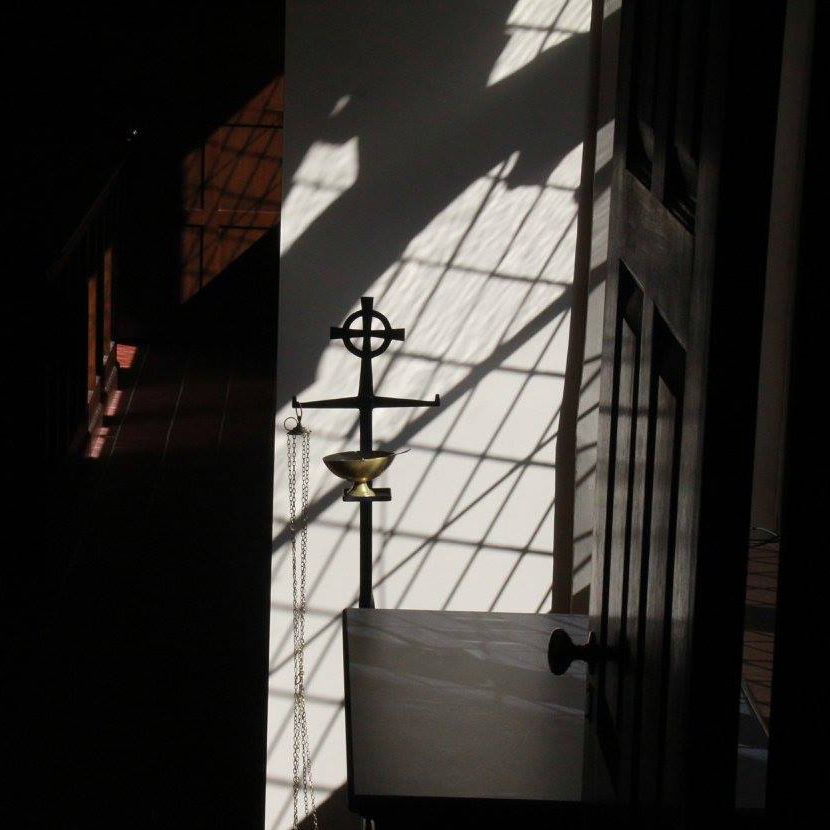My dear folk,
Perhaps the most characteristic devotion of Lent is the Stations of the Cross, also called the Way of the Cross. As most Catholic-minded parishes, All Saints’ has a set of Stations on the walls of the nave and we offer this devotion each year during Lent.
{grid8}Our Stations are almost a hundred years old, having been erected in 1921 during the rectorate of Fr. Blunt. It was under his leadership that the parish took the step from merely high church, beginning the use of colored vestments, High Mass as the principal service, the use of the dalmatic and tunicle for the Deacon and Subdeacon, Christmas midnight Mass, the Candlemas procession, the Altar of Repose on Maundy Thursday, and the Easter Vigil liturgy, to name but a few. He came from the Church of the Redeemer in the Hyde Park neighborhood of Chicago, one of the extreme parishes in that high church diocese (and from which parish – by then merged and no longer extreme – I was presented for confirmation while in graduate school). He was considered an “advanced” churchman and a “militant Catholic”; he regarded All Saints’ decision to call him as a warrant for significant movement “up the candle” as it used to be said.
Stations of the Cross is something of a virtual pilgrimage. Through the pictures, the readings, and the prayers, we accompany our Lord Jesus from his condemnation by Pontius Pilate through his burial. As pilgrims literally made – and still do make – this journey on the Via Dolorosa in Jerusalem, so all the faithful were able to participate in this devotion by imitation. It was widely popularized by the Franciscans, who were the custodians of the holy sites in Jerusalem and the Holy Land, and spread throughout the church from the fifteenth century onward. Both the number of stations and the specific events commemorated have varied in different places at different times, with as few as seven or as many as thirty-seven stations.
It has for some time been customary for there to be fourteen stations, stopping points for reflection and prayer along this journey: Jesus is condemned. The cross is laid on Jesus. Jesus falls under the weight of the cross. The cross is laid on Simon of Cyrene. And so on. However, All Saints’ Stations of the Cross has only ten stations. From the traditional fourteen it omits Jesus falling the second and third times, his meeting his mother along the way, and Veronica wiping his face. That omission of those four was a not uncommon, more “protestant” (i.e., less confidently catholic) version of the stations, which makes its appearance here at All Saints’ all the more curious given Fr. Blunt’s well-earned reputation as an advanced Catholic churchman.
Personally I have always found myself drawn to the Stations of the Cross. It is a salutary meditation which never seems to grow old. And, of course, I will never forget making that pilgrimage when Ruth and I were in Jerusalem. It was strange to actually be there, walking what we suppose to be the real Via Dolorosa – and if not perhaps on the exact spot where each of these things took place then certainly nearby, within a few blocks at the very most. The experience was also much more distracted than I’d expected: the noise and activity on the street, the would-be guides pestering you to hire them, the bright sun beating down and the heat (such a change from the frozen Vermont March we’d just left). And there were all the images of these events – from Sunday School papers through works of great art – cascading through my mind.
Prayer and meditation often come to mind when we think about growing in our spiritual lives. And the Stations of the Cross is a guided meditation. Yet while we talk about meditation, my experience both from people speaking with me as a priest as well as personally is that for most of us meditation is an idea which we think is good and could be helpful to us, but a practice we seldom get around to. Well, Stations of the Cross is a meditation which we make together. That group aspect together with tradition and custom help us get ourselves to actually do it. Our meditation in the Stations puts before us the unfathomable love of God in the redemption which Jesus’ sacrifice procured for us. We see the suffering Lamb of God offered for the sins of the world, who submitted himself to the will of the Father. We see the perfidy of those who denounced and condemned him. We see the faithfulness of the women who publically lamented for him (quite contrary to the law). We see Simon, compelled from the crowd to carry the cross for Jesus. We see the soldiers who carried out the monstrous routine of the torturous execution, and then played dice for the condemned man’s clothing. We see the dying Lord commend his dear mother to the care of the beloved disciple. We hear his anguished cry to his Father in abandonment on that cross. We see Our Lady hold her son’s lifeless body taken from the cross. And we see him placed in a grave – a borrowed one at that. And through it all we see the love of the one who chose to endue the shame and the death on the cross for love of us.
Several years ago I took some time to work through the version of the Stations of the Cross which we use here. I wanted to identify the sources of the collects and the meditations (which are almost entirely from the scriptures). It was an interesting exercise and certainly has enriched my experience in praying this devotion. But one thing surprised me: of the fourteen collects we pray, four of them are for Easter Day or the week after Easter. I expected many to be from Lent. But Easter? And what was one to make of those prayers which were intended for use in the midst of our greatest celebration and joy being so easily, indeed appropriately, used as we recalled the soul-wrenching cost of our salvation?
I believe that there is a profound truth which underlies that observation: the Passion of our Lord and his Resurrection are inseparable. One does not stand without the other. Our faith is neither one of deepest despair at sin and horror of what it does in human lives, nor is it a constant celebration which reveals it superficiality by not recognizing the cost. Our Lord’s death without his resurrection is a tragedy. And the resurrection without his death and passion is empty – it celebrates a victory which has not been won. We do not need to choose between these; indeed, we can not. Nor may we push one conveniently into the background for our comfort’s sake. They both are of the essence of the faith. Praise be to our God for giving us the victory in our Lord Jesus, who died for us and rose again. May he, who bought us with the price of his most precious blood, guard and protect us, and at the last bring us safely to our pilgrimage’s end.
Yours, in his service,
Michael J. Godderz+
{/grid8}{grid4_last}

(Ruth Godderz)
{/grid4_last}

